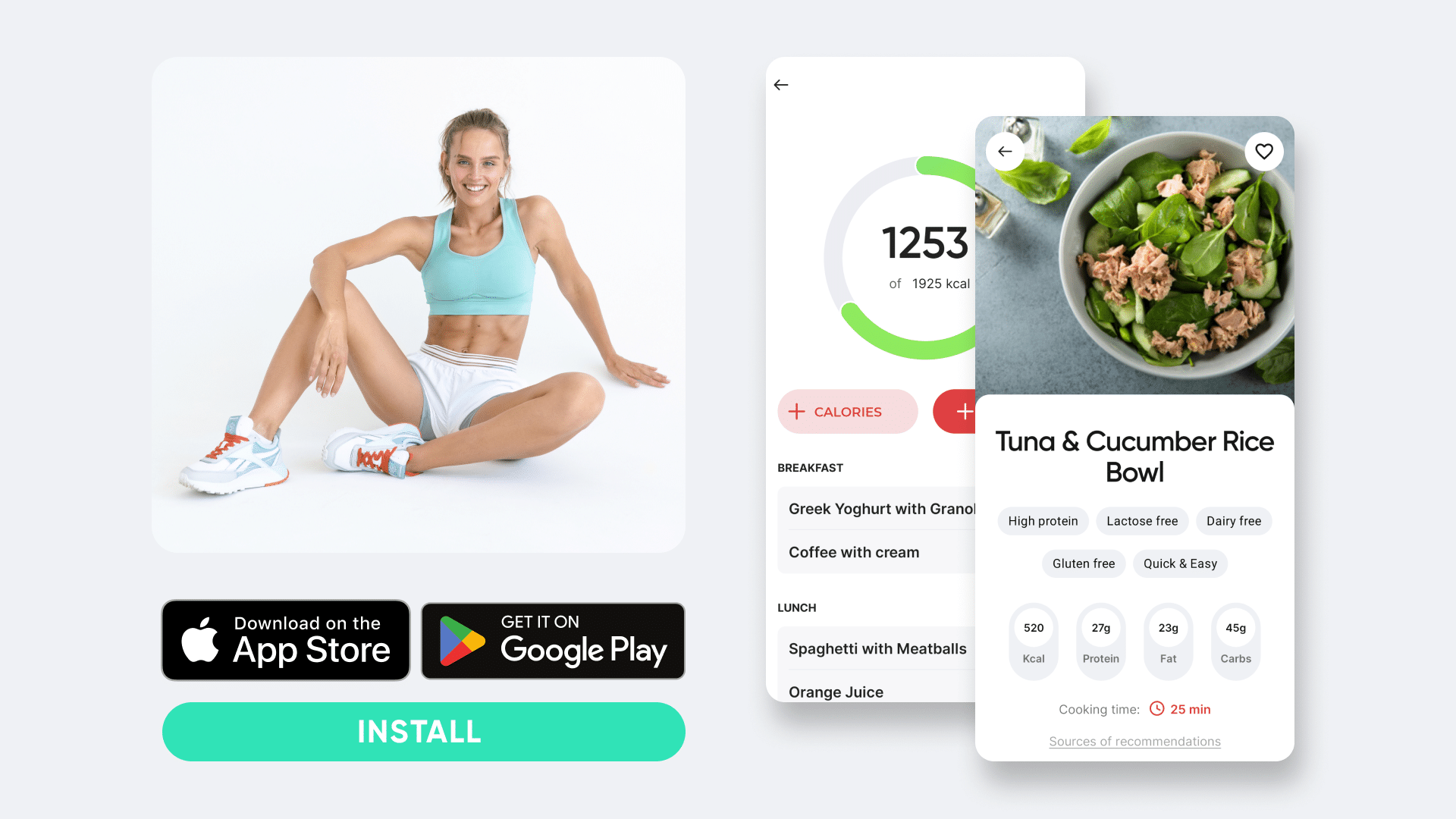In the hustle and bustle of modern life, healthy eating can feel like just another challenge. Processed foods and complicated recipes can lead to confusion, unhealthy choices, and a whole lot of stress. It’s time to embrace a simpler approach: the power of single-ingredient foods.
Embrace the Simplicity of Single-Ingredient Foods
The concept is simple. Single-ingredient foods are precisely that – foods that contain just one ingredient, unprocessed and unaltered from their natural state. Think:
- Fresh fruits and vegetables
- Lean proteins such as chicken, beef, and fish
- Whole grains such as brown rice and oats
- Healthy fats
- Plenty of water
Eggs, nuts, seeds, and spices are also great options. These foods provide optimal nutrition and flavor without the added sugars, sodium, and preservatives that are found in processed products [1].
Following the 80/20 Single-Ingredient Diet Rule
Some dieticians promote the 80/20 single-ingredient diet rule. It suggests that small changes can lead to significant improvements [2]. A gradual approach is key.
In the context of diet, the 80/20 rule means aiming for 80% of your diet to be whole, unprocessed 1-ingredient foods (such as fruits, vegetables, lean meats, whole grains) and 20% to be healthier prepared or packaged foods (such as granola bars, gluten-free snacks, occasional takeout).
They suggest logging your food intake for 1-2 weeks to gauge your current whole food vs. processed food ratio, then gradually increasing the whole food percentage over time. Don’t feel pressured to completely eliminate processed foods at once, but gradually shift your grocery shopping habits toward more whole foods until you reach the 80/20 balance.
When it comes to weight loss, progress is made by inches, not miles, so it’s much harder to track and a lot easier to give up. The BetterMe: Health Coaching app is your personal trainer, nutritionist, and support system all in one. Start using our app to stay on track and hold yourself accountable!
Understanding Single-Ingredient Foods
When you focus on single-ingredient foods, you naturally avoid many of the diet pitfalls that are hidden in packaged goods. Even foods marketed as “healthy” can contain surprising amounts of unwanted additives.
Opting for organic choices whenever possible and shopping in the perimeter of the grocery store (where the freshest foods tend to be) can further support your health goals [3]. By mixing and matching these wholesome ingredients, you can create a multitude of delicious, nutritious meals with minimal effort.
What Are Single-Ingredient Foods?
You can easily tap into the benefits of single-ingredient foods. These are foods with just one ingredient listed—such as chicken, beef, pork, fish, eggs, brown rice, sweet potatoes, oats, vegetables, nuts, oils, spices, and water.
These foods, especially when organic, are usually free of added sugars, sodium, and preservatives—common culprits that can sabotage a healthy diet. You’ll be amazed at the delicious, wholesome meals you can create by combining different single-ingredient foods.
As you start reading food labels, you’ll notice that some foods marketed as “healthy” are anything but that. Organic options are often better, if your budget allows. A good rule of thumb is to shop around the perimeter of the grocery store. The center aisles often contain the most processed foods, packed with preservatives and low in nutrients.
If you’re unsure where to start, just read the label. If the ingredients are difficult to pronounce or require a degree to understand, it’s best to look for alternatives. Keep it simple. Remember, many “healthy” foods are just well-marketed and not nutritious.
You’ll be surprised at how much better you feel when you swap out processed foods for wholesome, single-ingredient options. It’s always best to focus on “clean” eating—more chicken, turkey, fruits, vegetables, and other fresh foods.
Avoid Processed Foods
Ultra-processed foods are easy to spot. These foods are made using industrial methods such as splitting foods into parts, chemically altering them, and adding flavor enhancers [4]. They contain ingredients such as high-fructose corn syrup, hydrogenated oils, and other items that are rarely used in home kitchens.
These foods are cheap, convenient, and highly appealing. They’re designed to replace healthier, less processed options. To see if a food is ultra-processed, check the ingredients list for these types of items.
Ultra-processed foods often have:
- Low-cost ingredients
- A long shelf life
- Strong branding
They’re ready to eat and tend to displace other types of foods.
Single-Ingredient Food Grocery List
To help with planning, here’s a sample one-ingredient foods list to take with you on your next trip to the grocery store:
- Rice
- Oats
- Cauliflower
- Almonds
- Bananas
- Mangos
- Apples
- Carrots
- Corn
- Sunflower seeds
- Sweet potatoes
- Coconut
- Soybeans
- Chicken breast
- Lean ground beef
- Turkey
- Oat milk
Read more: 15 High Carb Foods To Avoid for Weight Loss and What To Eat Instead
Benefits of Single-Ingredient Foods
In an era that is dominated by processed and packaged foods, one-ingredient foods offer a refreshing alternative. These whole, unprocessed foods provide:
- Superior nutrition
- Promote overall health
- Simplify meal planning
By incorporating more single-ingredient foods into your diet, you can experience numerous benefits that enhance your well-being and streamline your approach to healthy eating.
Nutritional Benefits
One-ingredient foods are nutritional powerhouses. They are rich in vitamins, minerals, antioxidants, and fiber, which support optimal health and boost the immune system. These nutrients also play a crucial role in disease prevention, reducing the risk of chronic conditions such as[5]:
- Heart disease
- Diabetes
- Certain cancers
A diet that’s centered on whole foods can:
- Improve energy levels
- Promote healthy weight management
- Support digestive health
In addition, the antioxidants and phytochemicals in one-ingredient foods can:
- Combat inflammation
- Enhance cognitive function
- Support healthy aging
Variety of Single-Ingredient Foods
When it comes to healthy eating, many people think they need to sacrifice variety for nutrition. But with single-ingredient foods, you can have both. From lean proteins to colorful vegetables to healthy fats, the options are endless.
By incorporating a variety of whole foods into your diet, you can boost your immune system, increase your energy, and reduce your risk of chronic diseases [6]. With so many options to choose from, it’s easy to make a one-ingredient-foods list that supports your weight management goals.
From low-calorie vegetables to high-protein lean meats, whole foods make it easy to maintain a healthy weight. Plus, the nutrients in these foods support a healthy metabolism, which helps you reach and maintain your ideal weight.
Health and Wellness Advantages
One of the key benefits of a whole food diet is its ability to promote weight loss and support long-term weight management. One-ingredient foods tend to be lower in calories and higher in fiber and protein compared to processed options. This means they’re more satiating, keeping you fuller for longer and reducing the likelihood of overeating.
Also, the nutrients in whole foods support healthy metabolism and energy production, which helps with weight regulation [7]. By focusing on single-ingredient foods and limiting processed items, you can maintain a healthy weight more easily.
Simplification of Meal Planning
Beyond the health benefits, one of the greatest advantages of single-ingredient foods is the simplification of meal planning. With a focus on whole foods, you can eliminate the need for complicated recipes and lengthy grocery lists. Meal prep becomes a breeze, as you can simply combine a few single foods for a quick, nutritious meal.
Consider pairing grilled chicken with roasted vegetables, or topping a bed of greens with avocado, nuts, and a lean protein source. The possibilities are endless, and the meals are incredibly easy to prepare. This simplicity makes it easier to stick to a healthy eating plan, even on the busiest of days.
By focusing on single-ingredient foods, you can save time in two ways. Firstly, you’ll spend less time poring over complicated recipes and making lengthy grocery lists. Secondly, the meals themselves come together quickly, as you’re simply combining a few whole foods. This means you can have a healthy, delicious meal on the table in no time, even on the busiest days.
If you wish to free yourself from all the extra pounds that have been weighing you down for way too long, start using the BetterMe: Health Coaching app and overhaul your entire life!
How to Incorporate Single-Ingredient Foods into Your Diet
The good news is that incorporating more of these nutrient-dense foods into your diet is simpler than you may think, and can be a game-changer for individuals and families alike.
Easy Swaps and Additions
The key to successfully increasing your intake of single foods is to start by identifying areas in your current diet where processed snacks and meals can easily be swapped out for whole foods.
Trade in those bags of chips for fresh fruit or raw vegetables with hummus. Replace frozen dinners with home-cooked meals centered around lean proteins and sautéed greens. Gradually add more salads to your lunches and increase the amount of roasted vegetables on your dinner plate.
Getting your family on board can be a fun and educational experience. Involve your kids in the grocery shopping process and let them help pick out a new fruit or vegetable to try each week. Make meal prep a collaborative effort, with everyone lending a hand in the chopping and cooking.
Recipes and Meal Ideas
While 1-ingredient foods can be enjoyed on their own, combining them creates delicious and satisfying meals. Try pairing grilled chicken with roasted vegetables, or top a bed of greens with lean turkey and avocado. The possibilities are endless with whole foods.
Here are a few recipes to get you started:
- Grilled Chicken and Vegetable Kabobs: Alternate chunks of chicken breast, bell peppers, onions, and mushrooms on skewers. Brush with olive oil and grill until cooked through [8].
- Turkey and Avocado Salad: Top a bed of mixed greens with sliced lean turkey, diced avocado, cherry tomatoes, and a sprinkle of feta cheese. Drizzle with a homemade vinaigrette [9].
- Quinoa and Black Bean Bowl: Cook quinoa and black beans, then top with diced tomatoes, shredded lettuce, and a sprinkle of shredded cheese. Add a side of sautéed spinach with garlic [10].
The beauty of single-ingredient foods lies in their versatility. Don’t be afraid to experiment and come up with your own creations based on your favorite ingredients and dietary needs. With a little creativity and planning, you can easily make the swap to a healthier, more balanced diet that’s centered around whole, nutrient-dense foods.
Meal Prepping with Single-Ingredient Foods
Meal prepping with single-ingredient foods is a great way to simplify your diet while ensuring you eat healthy, nutritious meals throughout the week. Here’s how you can do it:
1. Choose Your Ingredients
- Proteins: Start with versatile proteins such as chicken, turkey, beef, pork, fish, or eggs.
- Starches: Include wholesome options such as brown rice, quinoa, sweet potatoes, or oats.
- Vegetables: Pick a variety of vegetables—broccoli, spinach, bell peppers, carrots, or zucchini.
- Healthy Fats: Use nuts, seeds, avocado, and oils such as olive or coconut oil.
- Spices and Herbs: Keep it simple with spices like salt, pepper, garlic, turmeric, or fresh herbs.
2. Cook in Batches
- Proteins: Grill, bake, or sauté large portions of your chosen proteins. For example, you can bake several chicken breasts or cook a batch of ground turkey.
- Starches: Cook grains such as rice or quinoa in bulk. Roast or boil sweet potatoes.
- Vegetables: Roast, steam, or sauté your vegetables. You can mix different vegetables for variety or cook them separately to combine later.
- Fats and Flavors: Toast nuts or seeds for added crunch and flavor. Prepare simple dressings with olive oil, lemon, and herbs.
3. Assemble Your Meals
- Mix and Match: Combine your prepped proteins, starches, and vegetables in different meals. For example, pair grilled chicken with quinoa and roasted vegetables one day, then mix it with brown rice and a different vegetable another day.
- Storage: Portion out your meals into containers. This makes it easy to grab a meal on busy days. You can store them in the fridge for a few days or freeze them for longer storage.
4. Keep It Fresh
- Add Variety: Change up your spices or herbs to create different flavor profiles each week.
- Fresh Produce: Supplement your prepped meals with fresh fruits or raw vegetables that you can quickly add before eating.
5. Benefits
- Time-Saving: Prepping meals in advance will save time during the week.
- Healthier Choices: With ready-made meals, you’re less likely to reach for processed or unhealthy options.
- Cost-Effective: Buying single-ingredient foods in bulk often reduces costs.
Meal prepping with single-ingredient foods helps you eat clean and stay organized, which makes it easier to maintain a healthy diet.
Read more: Energy-Boosting 8 Foods That Wake You Up
Common Misconceptions about Single-Ingredient Foods
When it comes to nutrition, simplicity can be a powerful tool. Single-ingredient foods – whole, unprocessed foods such as fruits, vegetables, lean proteins, and whole grains – offer numerous health benefits and incredible versatility.
However, misconceptions abound. Let’s debunk some common myths and explore practical solutions for incorporating single-ingredient foods in your diet, whether you’re a busy professional, an athlete, or a family who is looking for healthy meal ideas.
Debunking Myths
Myth: Single-ingredient foods are boring and restrictive.
Reality: With the vast array of whole foods available, it’s easy to add variety and flavor to your meals. Experiment with new fruits, vegetables, and seasonings to keep your diet interesting.
Myth: Single-ingredient foods are time-consuming to prepare.
Reality: Meal prep is a great solution for busy schedules. Roast a large batch of vegetables or grill several chicken breasts at once. These can be used throughout the week in various meals.
Myth: Single-ingredient foods are only for athletes or bodybuilders.
Reality: Single-ingredient foods provide essential nutrients for optimal health, which makes them beneficial for everyone, regardless of fitness goals.
Practical Solutions
Meal prep is a great solution for those with busy schedules. Roast a large batch of vegetables or grill several chicken breasts at once. They can be used throughout the week in various meals. Also, keep a bowl of fruit on the counter for an easy and healthy snack.
You can find single-ingredient foods to fit every lifestyle. Here are some examples:
- Busy Professionals: Keep a bowl of fruit on the counter for an easy and healthy snack. Consider meal prep on the weekends to set yourself up for success during the week.
- Athletes: Focus on lean proteins such as chicken, fish, and turkey, paired with complex carbohydrates such as sweet potatoes and brown rice. Don’t forget healthy fats such as nuts and seeds for added energy.
- Family Meals: Involve your kids in the cooking process. Let them help with meal prep or choose a new fruit or vegetable to try each week. This will encourage healthy eating habits from a young age.
Single-ingredient foods offer simplicity, versatility, and optimal nutrition for all. By debunking common misconceptions and finding practical solutions, anyone can harness the power of whole foods to fuel their best life.
FAQs
What are single-ingredient foods?
Single-ingredient foods are exactly that – foods that contain only one ingredient, unprocessed and unaltered from their natural state. Think:
- Fresh fruits and vegetables
- Lean proteins such as chicken, beef, and fish
- Whole grains such as brown rice and oats
- Healthy fats
- Plenty of water
- Eggs, nuts, seeds, and spices
What does the 80/20 rule mean?
Aim for 80% of your diet to be whole, unprocessed single-ingredient foods and 20% to be healthier, prepared or packaged foods. Log your food intake for 1-2 weeks, then gradually increase the whole food percentage over time.
How can I start incorporating them into my diet?
Start by making small swaps, such as choosing fresh fruit instead of packaged snacks. Gradually increase the amount of whole foods in your meals.
How can I make the most of single-ingredient foods?
Opt for organic choices whenever possible, shop around the perimeter of the grocery store, and mix and match wholesome ingredients.
Are single-ingredient foods more expensive?
While some whole foods may be pricier than processed alternatives, many are affordable. Buy in bulk and shop for seasonal produce to save money.
How can I identify ultra-processed foods?
Check the ingredients list for low-cost ingredients, a long shelf life, and strong branding.
Can I still enjoy diverse flavors and meals?
Absolutely! With the vast array of whole foods available, it’s easy to add variety and flavor to your meals. Experiment with new seasonings, herbs, and combinations of foods.
DISCLAIMER:
This article is intended for general informational purposes only and does not serve to address individual circumstances. It is not a substitute for professional advice or help and should not be relied on for making any kind of decision-making. Any action taken as a direct or indirect result of the information in this article is entirely at your own risk and is your sole responsibility.
BetterMe, its content staff, and its medical advisors accept no responsibility for inaccuracies, errors, misstatements, inconsistencies, or omissions and specifically disclaim any liability, loss or risk, personal, professional or otherwise, which may be incurred as a consequence, directly or indirectly, of the use and/or application of any content.
You should always seek the advice of your physician or other qualified health provider with any questions you may have regarding a medical condition or your specific situation. Never disregard professional medical advice or delay seeking it because of BetterMe content. If you suspect or think you may have a medical emergency, call your doctor.
SOURCES:
- Nutrition Benefits and Considerations for Whole Foods Plant-Based Eating Patterns (2022, https://www.ncbi.nlm.nih.gov/pmc/articles/PMC9189583/)
- Follow the 80/20 Rule to Transition to a Healthier Diet (2021, https://rhealthc.com/healthy-eating/follow-the-80-20-rule-to-transition-to-a-healthier-diet/)
- Nutrition and Healthy Eating (2022, https://www.mayoclinic.org/healthy-lifestyle/nutrition-and-healthy-eating/in-depth/organic-food/art-20043880)
- Ultra-Processed Foods: What They Are and How to Identify Them (2019, https://www.cambridge.org/core/journals/public-health-nutrition/article/ultraprocessed-foods-what-they-are-and-how-to-identifythem/E6D744D714B1FF09D5BCA3E74D53A185)
- Ultra-Processed Foods Increase Noncommunicable Chronic Disease Risk (2021, https://pubmed.ncbi.nlm.nih.gov/34798466/)
- The Role of Nutrition in Chronic Disease (2023, https://www.ncbi.nlm.nih.gov/pmc/articles/PMC9921002/)
- 12 Metabolism-Boosting Foods to Aid Weight Loss (2024, https://www.unitypoint.org/news-and-articles/12-metabolism-boosting-foods-to-aid-weight-loss)
- 30-Minute Easy Grilled Chicken and Vegetables (2022, https://simply-delicious-food.com/30-minute-easy-grilled-chicken-and-vegetables/)
- Leftover Turkey Salad (2024, https://healthyrecipesblogs.com/turkey-salad/)
- Quinoa Black Bean Burrito Bowls (2021, https://toriavey.com/quinoa-black-bean-burrito-bowls/)











